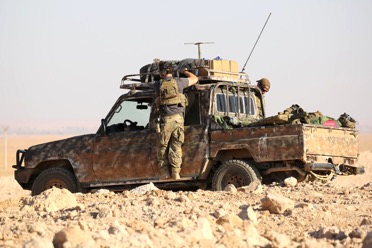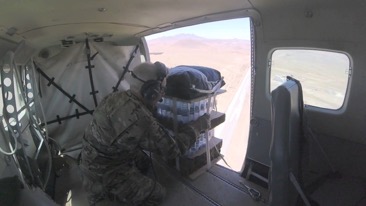The essence of flexibility is in the mind of the commander; the substance of flexibility is in logistics
– RADM Henry Eccles, U.S. Navy

Asymmetric Warfare’s central role in modern conflict has long been acknowledged by nations like Australia and the US. However, there still exists a disparity in the amount of attention paid to its different facets. While entire units have been stood up over the last half century to execute missions such as advanced force operations and unconventional warfare, investments in the training and application of nonstandard logistics (NSL) have been almost non-existent.
Loosely defined as the tailored use of conventional logistics in support of special operations or the use of specialised non-military logistics, NSL plays a major part in any asymmetric conflict, but is most often ignored until after an operation has already been initiated. The goal of this article is to explain the need for formalised NSL training, briefly cover the model of NSL in the US, highlight relevant case studies, and discuss methods for its practical application in militaries like the ADF.
Changes to the operational environment
While conventional logistics have long been mobilised in support of unique mission sets, key changes to the operational environment exist that will alter how and when NSL are conducted. First, Anti-Access Area Denial (A2/AD) efforts have significantly increased the likelihood that future conflicts will be fought in semi-denied or denied environments. Consequently, any units planning to engage in sustained operations using unconventional means will require adaptable logisticians prepared to solve complex problems in a clandestine and limited manner.
Second, forces like the ADF may increasingly find themselves engaged in novel environments that call for unconventional logistic solutions, such as in mega cities, most of which are in the Pacific region. Finally, the shift from counterterrorism and counterinsurgency to great power competition and deterrence will increase the need for subtle and flexible support to missions in austere environments. Rather than sending logistics personnel into this complex environment unprepared, leaders could implement institutional training that would provide the tools they need to succeed.
Historical case studies
The importance of NSL in asymmetric conflicts can be seen in two historical case studies: the fight between Soviet Partisans and Nazi occupying forces in WWII, and the joint-US-Northern Alliance effort in Afghanistan at the end of 2001.
In the first example, partisans were supported through captured materiel, pre-positioned caches, and air drops from the UK’s Special Operations Executive. These methods showcased the resourcefulness of the partisans and those supporting them when it came to limiting their footprint and avoiding attribution. The necessity of creativity was also shown in the use of 'mulberries' made from sunken ships and sandbars as piers when established harbours were controlled by the enemy. Despite overwhelming odds, these innovative logistics allowed the partisans to inflict over a million German casualties.
The second example involved the infiltration of Taliban-controlled Northern Afghanistan by US Special Forces following the attacks of September 11. The small teams worked with the Northern Alliance (NA) to locate targets and call in air strikes. While air-dropped bundles were often destroyed on impact due to poor planning, AK-47s were able to be provided to the NA by the CIA and local services were organized by the Afghan Territorial Force. More notably, US and NA forces traversed austere terrain on horseback. Similar to the case of the Soviet Partisans, the use of NSL allowed for disproportionate effects with limited exposure.
The US model
Unique approaches to logistic problems have been taken by US forces in multiple conflicts, including the Vietnam War, where units like the Counterinsurgency Support Office (CISO) supplied and sustained those operating covertly in denied environments across the border. CISO crafted sterilised uniforms and specialised tools for Studies and Observations Group members who often worked miles away from direct support and could not be claimed by the US government if captured.
This history of innovation born of necessity continued into the most recent conflicts in the Middle East, where conventional support units were often called upon to support Special Operations Forces (SOF) in austere environments.
After years of sustained conflict where these conventional units were often forced to learn through on-the-job training, multiple leaders spoke out about the need for organised education in NSL. These calls to action have slowly yielded results, with multiple attempts at formal NSL training taking form. One such attempt has been made by civilian organisations like Diversified Logistics Solutions who liaise with military units to offer training on the use of non-military systems and local resources that military units may lack experience with. SOF units and commands have also developed their own courses that add an emphasis on training military personnel on the adaption of conventional equipment and methods for unconventional environments. Additional efforts have been made by the US Army’s Security Force Assistance Brigades, who have recently shifted toward including unconventional small teams training in areas like intel and logistics.
This positive trend will most likely continue as further developments in training are made regarding areas like unconventional procurement, logistics denial, and cache development. These skills can be learnt by logistics leaders in SOF and beyond, who can then carry them back to their units and better prepare their services to fight in ambiguous and complex environments. This holds true in both the US military, and in partner forces like the ADF. While the force structures of these organisations and the challenges they are set to face are not identical, their need to pursue formal training in NSL is. The following section will highlight a few key suggestions as to how the ADF can implement such training.
Practical applications
While logistics units dedicated to special operations exist across multiple partner forces (e.g. the Special Operations Logistics Squadron), the goal of NSL training would be to extend the knowledge and skills necessary to operate in an unconventional fight to selected logisticians across the ADF. While future developments could be made in the form of advanced courses, the initial course of instruction should serve as a primer for support personnel set to operate outside conventional mission sets.
This training would ideally range between 1-4 weeks and would be taught on-location to various units using mobile training teams. This short time frame and dynamic course location would limit the costs to units while still covering the essential topics. Following the US model, these courses could be taught by civilian organisations, select military units, or even by groups within the national intelligence community.
A prototype curriculum could cover the following areas: comparisons between traditional and special warfare logistics, SOF support structures, A2/AD, clandestine procurement and distribution, and non-military support systems. If called for, further additions could be made in the areas of interagency/joint efforts and irregular warfare logistics funding and authorities. A possible consideration could be made for the inclusion of cross-training, where personnel learn all the skills (fuel, water, ammo, transportation, aerial delivery, etc.) necessary to support small teams in austere environments with limited external assistance.
Based on the requirements and implications of such a course, a rank requirement (e.g. CPL and above) could be instituted, wherein these leaders could then carry these lessons forward to their units and incorporate them into their mission preparation.
Aside from this formal course, the ADF could also increase their proficiency in NSL through the following means: the embedding of logistics personnel in SOF/paramilitary entities, the annual holding of a defence-industry-wide seminar, or the integration of NSL into large-scale training exercises. First, support personnel from units set to operate in unconventional environments could perform exchanges in external SOF organisations where they would learn best practices to take back to their units. Second an annual seminar could bring these practices and the newest innovations in NSL directly to the ADF, who could better network with civilian and interagency partners. Finally, pre-existing training exercises like Talisman Sabre could be augmented with nonstandard equipment and logistics challenges that better prepare personnel for the future fight.

Conclusion
The study and application of NSL will only continue to grow in importance as nations like Australia and the US enter the next generation of conflicts. The rise of A2/AD, the shift toward deterrence, and the introduction of operations in novel and complex environments all point toward the current need for appropriate training in NSL. The US has slowly risen to the challenge of instituting such training, in a trend that will hopefully spread to partner forces.
Through applying lessons learned from this model to its unique structure and strategic goals, the ADF can be a part of this trend and better prepare itself for future conflicts. This could include any of the methods outlined above, but ultimately it will be up to the logistics and SOF leaders of the ADF to make this change a reality. It is my hope that they accomplish this goal, and that this article helps them to do so.









